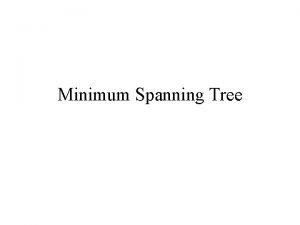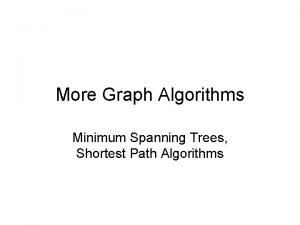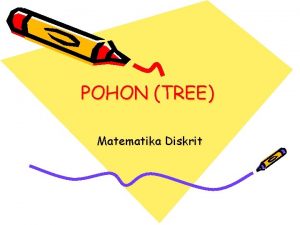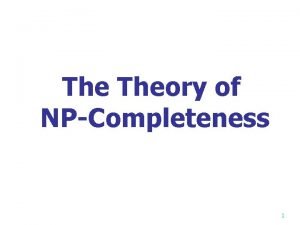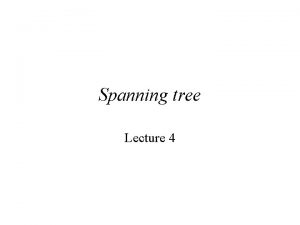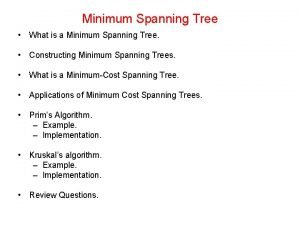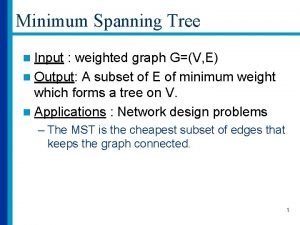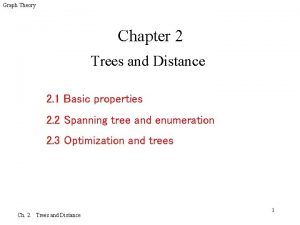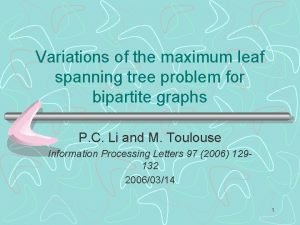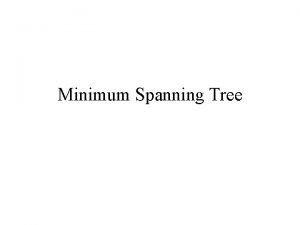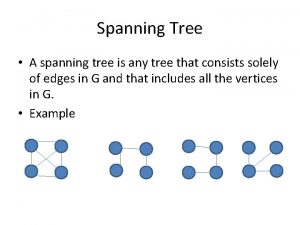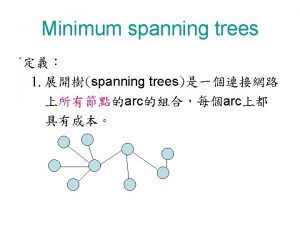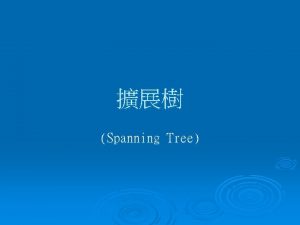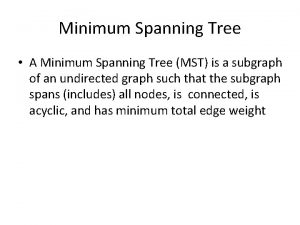Spanning Trees Spanning Trees A spanning tree for














- Slides: 14

Spanning Trees

Spanning Trees A spanning tree for a connected, undirected graph G is a graph S consisting of the nodes of G together with enough edges of G such that: 1. S is connected, and 2. S is acyclic. Example: E E A A D B B D C F C One of many Spanning Trees F Why “tree”? Pick any node as the root is a tree. Why “spanning”? Every node is (still) connected to every other node.

Algorithm for Generating a Spanning Tree A DFS algorithm works. Just keep the tree edges. A E B A B D C F O(m) = O(n 2) (worse case) C D E F

Spanning Trees for Weighted Graphs A minimal spanning tree for a weighted, connected, undirected graph G is a graph S consisting of the nodes of G together with enough edges of G such that: 1. S is connected, and 2. S is acyclic, and 3. S has minimal weight. Note: all weights positive. Examples: E 7 A 1 6 5 D 8 B 4 E 5 C A 2 6 5 D 1 F Weighted Graph B 4 E C 2 F 6 A D 1 5 B 4 C 2 F (Only) two minimal spanning trees

Kruskal’s Algorithm Sort edges by weight (smallest first) For each edge e = {x, y} (in order) if nodes x and y are not in the same connected component, then add e E 7 A 1 6 5 D 8 B 4 5 C 2 F {A, B} {D, F} {B, C} {A, D} {C, D} {E, D} {A, E} {B, D} 1 2 4 5 5 6 7 8 E A 6 5 D 1 B 4 C 2 F Could have stopped here… we had n-1 edges.

Kruskal’s Examples City connectivity S ------ C ------ N / / D ------ A $35 Atlanta Chicago $70 Atlanta Denver $40 Atlanta New York $65 Chicago Denver $50 Chicago New York $60 Chicago San Francisco $45 Denver San Francisco V = {a, b, c, d, e, f}, E = {{a, b}, {a, d}, {b, c}, {b, d}, {b, f}, {c, f}, {d, e}, {e, f}} {a, b}=8 {a, d}=11 {e, f}=2 {b, c}=7 {b, d}=6 {b, f}=4 {c, f}=14 {d, e}=1

Prim’s Algorithm Initialize a spanning tree S containing a single vertex, chosen arbitrarily from the graph Until n-1 edges have been added find the edge e = {x, y} such that x is in S and y is not in S e is the smallest weighted edge left Add e and y to S E 7 A (1) 1 5 (3) E 6 (5) 8 B 4 C (2) D 5 2 (4) F A 6 5 D 1 B 4 C 2 F

Correctness Proofs & Complexity Analysis Correctness Detailed proofs lengthy Essential idea: Prove connected: add edges until all nodes connected Prove acyclic: don’t add an edge that would create a cycle Prove minimal weight: only add overall or local minimal-weight edges Complexity Straightforward implementations are easy to analyze. Both algorithms have clever implementations that make them run faster.

Correctness of Prim’s Algorithm Prim’s algorithm produces a minimal spanning tree S from a connected, weighted, undirected graph G. Proof (sketch) Connected: Assume not, then there at least two disconnected components, C 1 and C 2 in S. But since G is connected, there is a smallest weight edge {x, y} with x in C 1 and y in C 2 that would have been found. Thus, after running Prim’s algorithm, C 1 and C 2 must be connected. Acyclic: Assume not, then there was a first edge {x, y} added to make a cycle. But to have been added, x must have been in S and y must not have been in S. Since y must not have been in S, there was no path from x to y at the time {x, y} was added, and thus no cycle was created when {x, y} was added. Minimal weight: By induction with loop invariant: After k iterations the growing spanning tree S has minimal weight. Basis: 0 iterations: The initialization step selects a single node and the weight of S is 0, the minimum possible since all weights are assumed to be positive. Induction: By the induction hypothesis, after k iterations S has minimal weight. Then, after k+1 iterations S has minimal weight. For suppose not, then the chosen edge e must not have been the smallest-weight edge left.

Complexity of Prim’s Algorithm Initialize a spanning tree S containing a single vertex, chosen arbitrarily from the graph Until n-1 edges have been added O(1) O(n) find the edge e = {x, y} such that x is in S and y is not in S e is the smallest weighted edge left Add e and y to S O(m) O(1) + O(n(m+1)) = O(nm) = O(n 3) in the worst case

A Faster Prim’s Algorithm To make Prim’s Algorithm faster, we need a way to find the edge e faster. Can we avoid looking through all edges in each iteration? We can if we sort them first and then make a sorted list of incident edges for each node. In the initialization step this takes O(mlogm) to sort and O(m) to make lists for each node O(mlogm) = O(n 2 logn 2) in the worst case. Now for each of the n 1 iterations, we find the edge {x, y} by looking only at the first edge of at most n lists O(n 2) over all iterations. We must, of course, discard edges on these lists as we build S, so that the edge we want will be first, but with appropriate links, this is O(1). Thus, the sort in the initialization dominates, which makes the algorithm O(mlogm) = O(n 2 logn 2) in the worst case. To make the algorithm even faster, we must somehow avoid the sort. Can we?

An Even Faster Prim’s Algorithm Start with the smallest-weight edge e = {x, y} in S O(m) O(n) discard x and y from the list of nodes to consider for both x and y, find the closest node, if any (among the nondiscarded nodes), and keep them and their edge weights Until n-1 edges have been added find the edge e = {x, y} such that x is in S and y is not in S e is the smallest weighted edge left add e and y to S discard y from the list of nodes to consider, and for both x and y, find the closest node, if any (among the non-discarded nodes), and keep them and their edge weights O(1) O(n) O(m) + O(n(n+1+n)) = O(n 2) in the worst case

Correctness of Kruskal’s Algorithm Kruskal’s algorithm produces a minimal spanning tree S from a connected, weighted, undirected graph G. Proof (sketch) Connected: Assume not, then there at least two disconnected components, C 1 and C 2 in S. But since G is connected, there is a smallest weight edge {x, y} with x in C 1 and y in C 2 that would have been added. Thus, after running Kruskal’s algorithm C 1 and C 2 must be connected. Acyclic: Assume not, then there was a first edge {x, y} added to make a cycle. But to have been added, x and y must have not been connected in S. Since x and y must not have been connected in S, there was no path from x to y at the time {x, y} was added, and thus no cycle was created when {x, y} was added. Minimal weight: …

Complexity of Kruskal’s Algorithm Sort edges by weight (smallest first) For each edge e={x, y}, until n 1 edges added if nodes x and y are not in the same connected component, add e O(mlogm) O(n), i. e. using DFS* O(1) O(mlogm) + O(nm) = O(n 2 logn 2) + O(n 3) = O(n 3) Can Kruskal’s algorithm be improved? Often already sorted (omit first step) Faster way to check “in same connected component” O(n 2 logn) *O(n) not O(m) because the edges for the DFS check are the edges added to the spanning tree so far, and there can never be more than n 1 edges in the spanning tree.
 Spanning trees
Spanning trees Minimum spanning tree
Minimum spanning tree Minimum spanning tree shortest path
Minimum spanning tree shortest path Diketahui 8 buah koin uang logam
Diketahui 8 buah koin uang logam Csc longin
Csc longin Non-deterministic algorithm
Non-deterministic algorithm Spanning tree algorithm in computer networks
Spanning tree algorithm in computer networks Minimum spanning tree
Minimum spanning tree Minimum cost spanning tree
Minimum cost spanning tree Minimum spanning tree weighted graph
Minimum spanning tree weighted graph Brily
Brily Asus spanning tree protocol
Asus spanning tree protocol Forest in graph theory
Forest in graph theory Minimum leaf spanning tree
Minimum leaf spanning tree Spanning tree of a graph
Spanning tree of a graph
